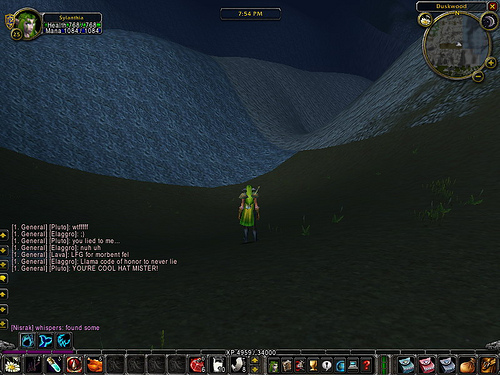
Credit: Screenshot by dyashman under an Attribution 2.0 Generic license
Image: The blurred boundary between the Stranglethorn Vale, Duskwood, and Deadwind Pass zones in World of Warcraft.
I posted this entry originally early in November, but somehow an entire paragraph disappeared, so I’ve re-posted it with a new date. — Michelle
_arien:
games based learning, i think has potential but learners struggle with transferring the learning & dealing with blurred boundaries #fote10Eingang:
@_arien I think you’re right that learners have trouble with learning when boundaries blurred like in GBL, because of context. #fote10_arien:
@Eingang exactly, our minds still work in boxes and takes practice to cross between formal and informal contextsEingang:
@_arien Blurred boundaries & different contexts are particularly problematic for, eg, people w autistic spectrum disorders. #h810 #fote10Eingang:
@_arien AR can help overcome the context issue/blurred boundaries of learning we were just discussing, because RL there too. #fote10
The above is an extract from a Twitter conversation I had on October 1st during the Future of Technology in Education conference (#fote10) with @_arien. Arien was attending the conference, watching Ollie Bray’s talk, while I was following the conference on Twitter. Arien, as it happens, is one of my Open University H810 students. Ollie Bray (@olliebray), of Learning & Teaching Scotland, was discussing the use of computer games in education.
I think Arien’s hit the nail on the head: it is about context. One of the reasons game skills don’t transfer to learning well is because learners/players do not see something in a game as being applicable to something academic. Much learning we do is completely context-based. Without the context of the “subject”, we do not necessarily think to apply something we have learned or maybe even realize that it is applicable.
That is, of course, only true when you are dealing with games intended to be games, and not necessarily with products developed or intended to be educational games. Let me clarify that with some examples. Ollie Bray talked about a handheld brain training game. One of the brain training game exercises has you complete as many math problems as you can within a certain time span. The math problems are usually simple addition or subtraction. While the object is to do as many as possible to achieve the highest score, the context of doing math problems is familiar and immediately recognizable. This particular “game” helps encourage the practice effect that is necessary for so much learning. The practice effect is also present in World of Warcraft, where someone may be doing complex comparisons of one set of gear statistics versus another. That also requires mathematical skills, but it is not obvious to the learner that they are practicing a math skill.
The gear statistics example from World of Warcraft is not, I admit, a good example, because it does not illustrate learning. Actually, technically speaking, neither example so far does. They are both about practicing skills. You have already learned how to do the math somewhere else. In the brain training example, the domain it is applied in is the same as how you likely learned the skill. In the World of Warcraft example, the domain is completely different and not so obviously related.
I think there is something here to explore about blurred boundaries and learning and I would like to return to it at a later point. Thank you, Arien, for starting me thinking about it.







